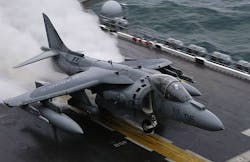Marine Corps AV-8B jump jet avionics mission computers to receive next-gen Ethernet capability
Officials of the Naval Air Systems Command at Patuxent River Naval Air Station, Md., announced their intention Friday to award a sole-source contract modification to General Dynamics Advanced Information Systems in Minneapolis to handle the upgrade. The value of the upcoming contract modification has yet to be negotiated.
Navy avionics experts are asking General Dynamics to change the second Open System Processor-Generation 3 (OSP3) to function with the future Ethernet cards and to update the data requirement.
This upgrade to the mission computers aboard the Marine Corps AV-8B attack jets is part of a series of avionics enhancements to keep the ageing military plane functioning for as long as possible. The Boeing AV-8B was designed in the 1970s and was produced from 1981 to 2003.
The plane's primary users are the U.S. Marine Corps, as well as the Italian and Spanish navies. The subsonic ground attack jet is designed to take off and land from short runways or from open fields with its vertical and short takeoff and landing (VSTOL) capability. Seven Marine Corps attack squadrons currently operate the AV-8B.
Related: Navy to install FACE-based avionics computer upgrade in Marine Corps AV-8B attack jet fleet
Navy officials are looking to Ethernet to expand the computer networking bandwidth aboard the AV-8B to accommodate modern advanced RF and electro-optical sensors, as well as advanced digital signal processing.
Two years ago Navy experts asked General Dynamics to upgrade the Marine Corps AV-8B aircraft with industry-standard avionics computer interfaces that meet guidelines of the Future Airborne Capability Environment (FACE).
Company experts provided the AV-8 mission computers with a FACE interface structure running on top of the system's existing Wind River Systems VxWorks-based core systems software.
Navy avionics experts ordered the FACE software upgrades to the Harrier's mission computer to enable the AV-8B's avionics to implement the required area navigation (RNP) and required navigation performance (RNAV) application.
Related: Navy looks to Hood Tech to provide non-contact jet engine blade vibration and monitoring
The AV-8B's advanced mission computer is a VME-based processing system based on the Freescale Power-PC open-systems processor architecture. The mission computer can control mission computers and displays, digital maps, network processors, and servers.
The FACE technical standard, administered by the FACE industry consortium, providing guidelines for creating a common operating environment to support applications across U.S. military avionics systems. The standard helps enable developers to create and deploy applications across many military aviation systems through a common operating environment.
Eventually the Marines will replace their AV-8B aircraft with vertical- and short-takeoff and landing versions of the Lockheed Martin F-35 joint strike fighter.
For more information contact General Dynamics Advanced Mission Systems online at www.gd-ais.com, or Naval Air Systems Command at www.navair.navy.mil.
